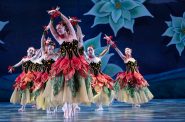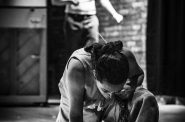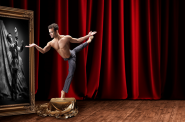Dancing outdoors with Stephan Koplowitz
UWM's Year of the Arts grand finale puts 30 dancers at the the North Avenue Water Tower and amid the fountains outside the Milwaukee Art Museum.
Stephan Koplowitz looked east, to Lake Michigan, south to a splashing fountain and north to the grand North Avenue Water Tower (and before it, Tuesday evening, to the Bel Canto Chorus in front of the tower). A few sprinkles of a just-passed thunderstorm fell, though the sky above was blue.
Water, water everywhere, and it clearly charmed the Los Angeles choreographer. He had never visited Milwaukee before starting work on the capstone dance project of UWM’s nearly-over Year of the Arts. Koplowitz, the dean of dance at Cal Arts, made two site-specific pieces for UWM dance students, one to perform at the Water Tower at the east end of North Avenue and the other at the Cudahy Gardens of the Milwaukee Art Museum. Water figures prominently in Dan Kiley’s design for the garden – a stream/fountain runs straight as a string for 600 feet to bisect the gardens, which separate Lincoln Memorial Drive from the lakefront museum.
“I settled on these sites because they’re iconic in Milwaukee,” Koplowitz said, before rehearsal Tuesday night. “One speaks to the past, the other to the present and future.”
As it happens, Koplowitz has pursued a fascination with water in Houston and in a series of projects in Los Angeles. Until he starting visiting Milwaukee, he knew nothing of the importance of water in the city’s history and future. It didn’t take long for him to recognize it and decide that water would permeate his Milwaukee work.
“It would be almost criminal to ignore it,” he said. “I think in terms of series, and Milwaukee offers such an abundance of sites that I proposed more. I thought about the river, Downtown, with dancers on boats…”
Budget and other aspects of reality limited Koplowitz to the present two locations, but both are spectacular and well suited to ideas about site-specific dance that he has developed in projects all over the U.S. and Europe.
“Every decision is a response to the site,” he said. “The reason I love site work is that it compels you to pull something different out of yourself.”
“I’m dealing with the design, referencing the pure lines, the flow of the water moving along, washing things, leaving artifacts behind,” Koplowitz said. “It’s a promenade piece. The audience will begin in the north square, then move to the next, the go up to the bridge to see the third part.”
He said that his dance will reference the Calatrava addition to the museum, and I could see that in the dancer’s shapes during a rehearsal Wednesday afternoon. But Koplowitz intends to turn the eye toward Kiley’s garden, which is as low and subtle and inviting as the Calatrava building is soaring and dynamic and overwhelming. Among other strategies, Koplowitz’s dancers will arrange themselves down the long axis of the garden, to heighten its beguiling perspective.
“I want people to see the gardens as they have never seen them before,” he said, sharing a sentiment that could apply to any of his site-specific works, including the The Current Past, at the tower.
That piece involves the Bel Canto Chorus, projections designed by Luc Vanier assembled (Vanier, of the UWM dance faculty, knows Koplowitz and is in large part responsible for bringing him here) as well as the dancers, and will take place at night with relatively controlled lighting conditions.
“In my mind, this was the least likely place for a piece, of all the locations I started scouting when I came here a year ago,” Koplowitz said. “How do you do something with such an oddly-placed structure?”
He took up the challenge because it is a challenge, and because he relished the chance to give new context to a building that is well-known and loved, but like all familiar things taken for granted.
His first thought was to have the audience follow the dance around the tower. But a closer look showed the tower has a face — the south side — and a back side on the north. He decided to make the piece presentational, with the audience remaining on the south side of the tower throughout. The audience will start with its back to the tower facing the Bel Canto Chorus, arrayed on risers, with music director Richard Hynson conducting. They will sing a wordless, stretched-out version of Hynson’s “Blessed Are the Dead,” which he rearranged for the occasion. The audience will then turn north, and dancers will emerge from behind the tower.
“The music will wash over them from behind,” Koplowitz said. “I always incorporate singing. I love the sound of the human voice. I asked Rick to remove the words, to slow it down and to phase the piece, so we hear it [in canon] one bar apart. That’s why the risers are split — two choirs. You get this sense of cascading sound — the singing is like water enveloping the audience.”
Likewise, the dancers flow in circular fashion, always entering stage left and exiting stage right. They will settle into dance vignettes in the center but inevitably return to the watery flow of the piece. They will move in harmony with the music and with the digital images — many of them created at UWM’s School of Freshwater Science — projected onto the tower above them.
“I’ve accepted the fact that the tower will pull focus,” Koplowitz said. “This piece has one foot in dance and one foot in installation art. I’m trying to balance the dance and the projections so that all the elements enhance each other.”
Both works run for about a half an hour — substantial enough to bring out the dance audience, but brief enough to hold passers-by.
“My work is accessible, and I make no excuses for that,” Koplowitz said.
As he scouted the site during prior visits, Koplowitz asked people about their and memories of the tower and what it means to them. Tuesday, I shared mine: Artist Therese Agnew’s fiberglass dragon perched high on the tower in 1985, a project that generated thousands of photographs. The whimsy and audacity of Agnew’s dragon made the tower the talk of the town for months.
“That’s what I want, for this to be part of that memory,” Koplowitz said. “This isn’t a gimmick. I want the piece to be transformative, so people never see the tower the same again.”
The schedule, June 13-15: 9 p.m. Thursday-Saturday at North Point Water Tower; 6 p.m. Friday and 3 p.m. Saturday at the Milwaukee Art Museum. Admission is free.
Dance
-
Milwaukee Ballet Brings Back Orchestra
 Jul 14th, 2025 by Bruce Murphy
Jul 14th, 2025 by Bruce Murphy
-
New Riverwest Company, Production Impresses
 Feb 10th, 2020 by Brendan Fox
Feb 10th, 2020 by Brendan Fox
-
Milwaukee Ballet Show Remakes History
 Feb 10th, 2020 by Catherine Jozwik
Feb 10th, 2020 by Catherine Jozwik






















I remember Teresa Agnew’s splendid Dragon on the Water Tower
in 1985! I hope to see Koplowitz’s dance compositions Saturday at MAM, and if I’m lucky, Friday night at Water Tower place too! Thanks for the well-written article!